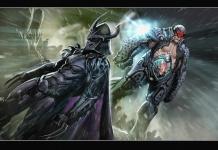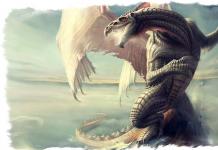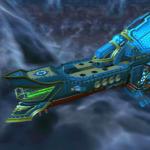In the mythology of Ancient Scandinavia, Nidhogg is the name of the great dragon who lives at the roots of the tree Yggdrasil. In Snorri Sturluson's Prose Edda, it is said that the dragon Nidhogg lives at the foot of the Boiling Cauldron spring, which is located under the third root of Yggdrasil (this root, as explained in the Edda, “stretches to Niflheim”).
It is important to note: despite the fact that, according to the original Eddic text, Nidhogg lives precisely in Niflheim, there is an assumption that the dragon is located specifically in the world of the dead - Helheim (which is precisely one of the internal locations of Niflheim). In the Younger Edda, Sturluson quotes lines from the Elder Edda, where it is said that Nidhogg “devours the corpses of the dead.” Obviously, the dragon would not be able to find the “corpses of the dead” in the world of frost giants, but in the world of Hel he could.
It is curious that in the Elder Edda there is an indication (which Sturluson somehow misses) according to which the dragon Nidhogg eats only the corpses of those who have broken the law - murderers, “seducers of other people's wives” and oathbreakers. At the same time, the etymology of the Old Icelandic word “Níðhǫggr” does not have a clearly proven interpretation. According to one version, it is translated as “devouring corpses”, according to another - “black dragon”, according to the third - “inhabitant of the underworld”.
Traditionally, Nidhogg is placed on a par with Jormungandr and Fafnir, although in fact such an analogy looks strange. The only thing Nidhogg has in common with Fafnir is that they are both dragons. But Nidhogg is a dragon by birth, and Fafnir is a werewolf, the son of the sorcerer Hreidmar. Moreover, Nidhogg is a chthonic monster, and this unites him with Jormungandr, who, being a “great serpent,” is not a dragon. However, in the Prose Edda, Sturluson mentions that with Nidhogg in the source of the Boiling Cauldron live snakes that are “innumerable.” That is, the “snake-likeness” of the image is still obvious.
Another Eddic episode is also interesting, which says that the dragon Nidhogg, who lives under the roots of Yggdrasil, is in constant enmity with the eagle that lives at the top of the crown of the World Tree. The dragon and the eagle constantly “shower each other with swear words,” but since the distance between them is great, the messages from one to the other are carried by a squirrel named Ratatoskr. In the context of this myth, the dialectical principle of unity and struggle of opposites (Yin-Yang in the Eastern tradition) is obvious. Nidhogg personifies “bottom”, the eagle represents “top”, both are an integral part of the structure of Yggdrasil and try to resist each other, but not directly, but through an intermediary (metaphorically, a person who, like a squirrel, rushes between opposing desires).
Moreover, in both Eddas it is said that the dragon Nidhogg tirelessly gnaws at the roots of Yggdrasil, while the eagle’s companions - four great deer - gnaw at its crown. That is, both “top” and “bottom” tirelessly destroy the structure of which they are a part. Hence the whole complexity of the bright, epic image of Nidhogg, which, unfortunately, is not mentioned in any other ancient text. In particular, it is unknown what happened to the dragon subsequently - after Ragnarok and the collapse of the world with its subsequent rebirth.
The snake in Scandinavian culture has a rather narrow symbolism, compared to its role even in pan-Indo-European mythology, not to mention world mythology. In the myths of the peoples of Europe, Africa, and Southeast Asia, the snake (as well as the snake - bird, or the snake - horse, that is, the dragon) plays a huge role, although it has an ambivalent meaning.
It is connected with earth, and with sky, and with water, and with fire. And the serpent of northern mythology, especially in the incarnation of Jormungandr - the World Serpent (and the dragon Fafnir) has a narrower semantic range and, one might say, a more tragic character. Here we will talk mostly about the Scandinavian specifics of the image.
Snake and serpent
In the mythological consciousness, the serpent is usually distinguished from the serpent. Not so much by gender, but by character and importance. The snake is either one of many snakes, a people of snakes, or “a crowd of creeping, and most importantly poisonous, reptiles,” or a princess - a snake, half-woman, half-snake. The snake is generally considered to be more venomous than snakes and more harmful. The snake can be associated with erotic and phallic symbolism (this is exactly the case among the Slavs). This includes beliefs about a flying serpent (Fire Wolf Snake) visiting women at night, yearning for male affection. A snake can have its own name, be incredibly huge and serve some purpose. The serpent Nidhogg and the serpent Jormungandr have their purpose in Scandinavian mythology. The first, along with a host of snakes, devours the roots of the Yggdrasil ash tree, which gradually leads to his death and the death of the whole world.
Water, earth and the underworld
Amphibians are naturally associated primarily with the water and earth elements. In Russian, the words “earth” and “snake” are etymologically related and sound similar, which is successfully used in spells and rituals, against a snake bite, for example. Snakes are also used in rainmaking rituals (the snake is killed and hung on a tree). The snake is also related to the “locking in” of moisture, that is, to drought. Numerous stories are connected with this and a snake - a dragon, sitting at the only source of water in some area and demanding maidens.
Snakes are associated with the chthonic, underground world (including because of their winter quarters in the ground). It is because of this that they become opponents of the sun and the solar deity: the Greek Apollo, the Christian George and others. The serpent can be an intermediary between the dead (ancestors) and the living. A dead person seems to go to the snakes, to their kingdom. In fairy tales, the snake is the guardian, or king, of the underworld.
"Belt of the Universe"
The role of the serpent in the world often has a cosmological character. In Slavic beliefs of apocryphal origin, the earth rests on a snake swimming in the sea, whose head meets its tail, or on four pillars guarded by huge snakes that gnaw them as the world sinks into sin. These beliefs are similar to the ideas of the Scandinavians of the Viking Age about the serpent Jormungandr, who goes around the entire land and lies in the sea, biting his tail, and about snakes gnawing the support of the world - the ash tree Yggdrasil.
Jörmungandr means "Great Staff". Midgardorm is also his name, meaning "Midgard serpent". This is a giant snake that lives in the world's oceans and encircles the whole world. Thus, it is the boundary of the world and marks the limit of the universe. He is the "girdle of the universe." Its function in this is similar to the function of the World Tree, which is the frame, the matrix of the universe, at the same time denoting its boundaries, as well as the boundaries between worlds within the universe itself. Being the horizontal limit of the world, the serpent Jormungandr bears a name that indicates its role as the “vertical matrix of the world.” The name "Great Staff" can certainly be associated with the World Tree itself - Yggdrasil. (And among the Saxons, their “pillar - idol”, symbolizing the World Tree, was called Irminsul, a name related to the name of the snake.)
The fate of Jormungandr and Yggdrasil is also similar. They both die at the Death of this World. Apparently Jormungandr was not initially the focus of evil, and became a monster hostile to the world, contrary to its function - to protect this world. There may still be discrepancies in what kind of world the snake protects. It seems that initially, in accordance with its role, similar to the role of the World Tree, Jormungandr encircled all the worlds, from Asgard and Midgard to Utgard - the outlying lands, beyond and around which the World Ocean was located.
With the narrowing of the mythological space and the emergence of strong eschatological concepts, Jormungandr became an evil monster entwining the world of Midgard and waiting for the moment when this world could be destroyed. Indeed, with the destruction of the world, the great serpent, as the border of this world, will also have to perish. But the role of Jormungandr from initially neutral becomes “villainous”. He is Thor's main opponent and they kill each other in the Last Battle.
It can be assumed that initially Jormungandr was a neutral force, a serpent encircling the entire universe horizontally, including Midgard and Utgard, lying in the World Ocean. And Thor was a thunder god who, in addition, gave people fertility. Then, from a certain point, strong eschatological tendencies arise: it becomes clear that the world is heading towards its destruction. This is accompanied by a narrowing of the physical space a person can comprehend. Utgard and Jotunheim cease to exist in the horizontal, accessible plane of the world. At the same time, the World Ocean is physically accessible (here we may have in mind, first of all, the voyages of Viking Age sailors across the Atlantic Ocean). And there certainly lies the Sea Serpent (ships sink, people die). And he is no longer neutral in a world where everything and everyone is divided into friends and strangers. He turns out to be an enemy of the world order, just waiting to squeeze and bite. Thor, in turn, reflects the view of the Viking Age people on the world. He protects his own and hits the right and the wrong with a hammer, if they are strangers. He walks as a border guard, protecting Asgard and Midgard from monsters and giants. It is not surprising that his main opponent is his “competitor - border guard” Jormungandr. With the narrowing of the conceivable world, they are trying to guard the same border - the border of Midgard. Thus, Jormungandr and Thor share the same fate: to be the border or protector of the world and die at its demise.
Giant Attribute: Source of Poison
Snakes are often an attribute of evil creatures, such as giants and giantesses. In the underworld, where other giants live, there are many snakes and poisonous objects. There are giantesses riding wolves, and they have snakes instead of bits. This is the giantess Hurrokin, who moved Balder's posthumous ship. This is a nameless giantess who wanted to accompany Hedin (and he refused her) from “The Song of Helgi, the son of Hjorvard”: “Hedin was riding home from the forest on the evening of Yule and met a troll woman. She rode on a wolf, and snakes were her bit. ".
Also, poisonous snakes turn out to be a villainous way to kill the hero. In the Volsunga Saga, King Gunnar is thrown into a pit with poisonous snakes. He is there playing the harp with his toes and all the snakes except one have fallen asleep. And the one that did not fall asleep was a large and evil viper. She bit King Gunnar in the heart. But he also breathed his last “with great courage.”
Fafnir and the Dragon Hoards
The most famous dragon guarding treasure in Scandinavian mythology is the dragon Fafnir. Later, stories about dragons guarding wealth would fill European medieval legends. The dragon Fafnir was formerly a man. but out of great greed and malice he became a dragon. As they say in the Saga of the Volsungs: “He became so fierce that he left the people and did not want anyone to enjoy the treasure except himself, and then he turned into a fierce snake and now lies near this treasure.” And he had a helmet - a scarecrow that all living things were afraid of. At the same time, it is believed that Fafnir is not the only representative of his species in the world. It is said that his height is normal - like that of steppe snakes. (As if the existence of large snakes - dragons, in general, is the most common thing in the world.) Whether all the other dragons kept wealth with them is unknown to us.
Having killed the dragon, the hero Sigurd takes away all his treasures: “Sigurd found there a lot of gold and that sword Hrotti, and there he took a fearsome helmet and golden armor and a pile of treasures. He found so much gold there that it seemed they couldn’t take it down.” two horses or three. He takes out all this gold and puts it in two huge chests."
The Snake's Gaze and the Snake's Tongue
The look of a snake is traditionally considered magical. In some Slavic beliefs, the snake draws power from the sun with its gaze. (We’ll keep silent about the saying about the relationship between a rabbit and a boa constrictor.)
We see the idea that a person can have a similar view among the Scandinavians (who always pay attention to the manifestations of strength in a person). In Halfdan Eysteinsson's Saga and Ragnar Leatherpants' Saga, Sigurd the Snake-in-the-Eye is mentioned. He received his nickname because, looking into his eyes, one would think that a coiled snake was hiding in them. This sparkle in the eyes was also attributed to all people from the Volsung family.
34
ruddy face,
and the hair is blond,
his gaze was
like a snake, scary.
(Song about Riga)
If the “look of a serpent” was considered an almost necessary quality of a true leader, then the skalds more often got the “snake tongue”. The famous skald Gunnlaug Snaketongue is a quarrelsome and quarrelsome person, especially in his youth, but an excellent skald, endowed with the gift of composing very sarcastic poetry. Skaldic poems outside the framework of laudatory and panegyric poetry were often offensive or ambiguous. Not to mention the special genre of slanderous poetry, even within the framework of love poetry, skalds managed to subtly ridicule their rival in their poems (usually the objects of their desires already belonged to other men).
Magic abilities (when eaten by a snake)
Eating a snake (not an ordinary one, but some special one) leads to the acquisition of magical abilities. In particular, understanding the language of animals and birds, and therefore, a prophetic gift. This plot device is found in later European tales and in sagas from mythological times. More precisely in the "Saga of the Volsungs". “Then he swung the sword that Gram and cut off Regin’s head, and then he ate part of the snake’s heart, and kept part of it,” it is told about Sigurd. After this, Sigurd realizes that the birds are chirping and does not allow Regina to deceive and kill himself, but kills him himself. And then he becomes even wiser than all people.
But this is not even the only snake-eating episode in the saga. Sigurd's grandfather Sigmund puts a snake in flour and tests his sister's sons for fear and courage. When they fail the test, he kills them. Only his own blood son Sinfiotli managed. He kneads the snake into the dough. The snake turns out to be poisonous and they did not eat poisonous bread that time. However, Sigmund was immune to snake venom and could absorb it as much as he liked. And Sinfjotli could only tolerate poison from the outside, but could neither eat it nor drink it, which as a result led to his death. But here we can say that absorption - the habit of consuming poison leads Sigmund to the ability to tolerate it.
And in order to incite Gottorm to kill Sigurd, he was given wolf and snake meat to eat:
"They took the underwater fish,
cut wolf meat
Dali Gottorm
Gehry's flesh
With foamy beer
and other potions
Brewed with enchantment...
And from this food he became cruel and greedy, and the plots of Hrimhild inflamed him so much that he swore to do this deed: besides, they promised him great honors for this." Here Gottorm acquires not wisdom, but anger and "poisonousness."
There is an interesting parallel: Sigurd eats the heart of the serpent Fafnir, Gunnar (his friend and one of the initiators of the murder) is thrown into a snake pen, and Högni (the third brother - brother-in-law and participant in the murder of Sigurd) has his heart cut out, just as Sigurd cut out Fafnir's heart in order to eat his. As if by eating Fafnir's heart, Sigurd becomes like him, and Sigurd's killers are killed by snakes.
Kennings named snakes
Kennings with the name of snakes are used to designate weapons and the two seasons accepted in Iceland - winter and summer. Winter is the “sorrow of serpents,” and summer is the “joy of serpents.” Accordingly, in more complex kennings, summer can be “the joy of the fish of the highlands” (the fish of the highlands are snakes), as Hurd said in The Saga of Hurd and the Islanders:
With the joy of the fish of the highlands
And the sorrow of the snakes into exile
I am doomed to live from now on.
In kennings of piercing weapons, the image of a snake (or fish) can be used. So the sword is a “snake of blood”.
8
Name given by Helgi
and lands: Hringstadir,
Solfjöll and Snefjöll,
and Cigarsvellir,
Hringsted, Hatun
and Khiminvangar -
and the blood of the snake
brother Sinfjotli.
(First Song of Helga the Slayer of Hunding)
The "Language of Poetry" mentions the poetic names of snakes: "Dragon", "Fafnir", "Jörmungandr", "Viper", "Nidhogg", "Snake", "Gad", "Goin", "Moin", "Gravvitnir", “Grayback”, “Sweeper”, “Sleeper”, “Vicious”. They are all written as proper names, which is also remarkable.
Serpent on the sword
Language images are closely related to ritual activity. And the commonly used kennings, expressed materially, certainly enhanced the subject itself. So the serpent carved on the sword (“snake of blood”) strengthened the sword itself. The Song of Helgi son of Hjorvard speaks of such a sword:
9
Handle with ring,
courage in the blade,
fear at the forefront
for those whose he will become;
on the blade of snakes
lay down bloodied,
the other wraps around
tail handle."
There are two snakes here: one is actually the “snake of blood” - a bloody snake that strikes its enemies, and the other is a snake that protects the owner, a snake that wraps around the handle.
Ships
The favorite children of the Scandinavians were not the first-born males of a rich and noble wife, but Viking ships. Not being an expert on ships (this book is not about life and material culture, but mostly about symbols), I will try to be extremely careful. In this case, we are interested in the connection between Viking ships and snakes. It exists and is significant.
The warships (on which the Vikings carried out their raids on land and fought with others at sea) were called "longships", that is, dragons. The bow of the ship was usually decorated with the head of some kind of monster, most often of the dragon-snake kind. The construction of one of the most famous longships - the Great or Great Serpent - is described in the Saga of Olav Tryggvason: “The next winter after King Olav returned from Halogaland, he ordered a large ship to be built under the Hladir rocks. It was much larger than all the other ships that were then in the country, and the platform on which it was built still remains... It was a ship with a dragon's head on the bow and made after the model of the Serpent that the king brought from Halogaland. But it was much larger and more more carefully made in every respect. The king called him the Great Serpent, and the other - the Small Serpent. The Great Serpent had thirty-four benches for rowers. The head and tail of the dragon were entirely gilded, and the side was as high as on sea ships. Of all ships , built in Norway, it was the best made and required the greatest expense." The image of a serpent - a dragon, an amphibious and dangerous creature, a relative of the “Staff of the Universe”, was perfectly suited for swimming.
In addition, the Scandinavians also buried their people in ships, burying boats with dead people, utensils and killed animals in mounds. And for those who did not have enough money for a funeral boat, they placed stones in the shape of a boat, preserving the symbol itself.
Bednenko G.B., 2002
Dragons in mythology
The first mention of dragons dates back to the ancient Sumerian culture. In ancient legends there are descriptions of the dragon as an amazing creature, unlike any other animal and at the same time resembling many of them. According to ancient Akkadian sources, the dragon had the paws of a dog, the head of a lion, and the wings of a bird. The image of the dragon appears in almost all creation myths. The sacred texts of ancient peoples identify it with the primordial power of the earth, the primordial Chaos, which enters into battle with the Creator.
In these cosmic battles, as a rule, the forces or gods who personify order and maintain balance in the universe win, and from the monster the firmament and the celestial world are created: “And he cut her insides, and pierced her heart... and from one half he created the firmament of heaven, and from the other - the firmament of the earth." In every country, poets sang of this titanic battle. The ancient Babylonian legend Enuma Elish talks about the struggle of the god Marduk with Tiamat, the goddess of the primeval cosmic ocean. One of the gods of the Vedic pantheon, Indra, defeats the dragon Vritra, the Semitic god Baal defeats the god Yama, the lord of the primordial ocean. The biblical story about the monster Leviathan, once defeated by the Creator, is also widely known.
The dragon symbol is the emblem of warriors on Parthian and Roman standards, the national emblem of Wales, the guardian depicted on the prows of ancient Viking ships. Among the Romans, the dragon was the badge of a cohort, hence the modern word dragoon. The dragon symbol is a symbol of supreme power among the Celts, a symbol of the Chinese emperor: his face was called the Face of the Dragon, and his throne was called the Dragon Throne. On the shield of Agamemnon (11th song of the Iliad) a blue three-headed dragon was depicted. The legends of Buddhism are replete with references to dragons, and the tales of Taoism tell of their deeds. Dragons, in the mythology of different peoples, are winged monsters, in the images of which animals were combined, embodying two worlds - heaven and earth - the upper (birds) and the lower (snakes). These fantastic creatures in Chinese mythology personified the masculine principle, the primary element of yang, together with the phoenix, embodying the feminine principle, the primary element of yin. The image of a dragon served as a symbol of the emperor, and a phoenix - of the empress.
In medieval alchemy, primordial matter (or otherwise the world substance) was designated by the most ancient alchemical symbol - a snake-dragon biting its own tail and called ouroboros (“tail eater”). The image of the ouroboros was accompanied by the caption “All in One or One in All.” And Creation was called circular (circulare) or wheel (rota). In the Middle Ages, when depicting a dragon, different parts of the body were “borrowed” from various animals, and, like the Sphinx, the dragon was a symbol of the unity of the four elements.
One of the most common mythological plots is a battle with a dragon: the hero, thanks to his courage, defeats the dragon, takes possession of its treasures, or frees a captive princess. This plot tells about the duality of human nature, about the internal conflict between light and darkness, about the forces of the unconscious, which can be used to achieve both creative and destructive goals. The battle with the dragon symbolizes the difficulties that a person must overcome in order to master the treasures of inner knowledge, defeat his base, dark nature and achieve self-control. The labors of Hercules, the liberation of Andromeda by Perseus, the battle of Jason with the dragon in the tale of the Argonauts, the legend of the Scandinavian hero Sigurd and his victory over the dragon Fafnir, the battle of St. George with the dragon are just some examples of this. Each of them gives their own advice on how to fight their own darkness. And although the dragon, like the Egyptian Seth, causes severe pain, it helps a person to know himself.
Dragons were symbols of powerful life-giving gods: Quetzalcoatl, god of the morning star, Atum, god of eternity, Serapis, god of wisdom. This symbol is endless, just as the ever-evolving world, protected by the Ouroboros ring, is endless.
Mythical dragons and wyverns are present in one form or another in the legends of almost all peoples of the world. Where did the first mentions of dragons come from and what significance do they have for humans? And why have they always aroused interest and admiration among people?
In the article:
Dragons and wyverns in the most ancient myths
Creatures similar to winged reptiles that breathed fire and possessed enormous strength have been known to mankind since ancient times. So, similar images existed back in the Stone Age. Rock paintings in many countries of the world depict not only scenes from the real life of people, but also fantastic creatures, some of which are very reminiscent of dragons. However, these drawings could not allow scientists and researchers to fully restore the picture of ancient beliefs and traditions.
 The first written sources allowing us to reconstruct ancient myths about dragons were the hieroglyphic inscriptions of Ancient Egypt and the Sumerian-Babylonian epic. In these legends, the giant reptile acted as an eternal evil that heroes or gods fought against. Thus, in Ancient Babylon, the goddess Tiamat possessed the image of a dragon, who was killed by Marduk, her grandson. And in Ancient Egypt, the form of a huge reptile, trying to devour the Sun, was Apep. He was opposed by the god Ra, who almost always defeated the beast. The exception was the days of solar eclipses, when the monster briefly managed to absorb the luminary.
The first written sources allowing us to reconstruct ancient myths about dragons were the hieroglyphic inscriptions of Ancient Egypt and the Sumerian-Babylonian epic. In these legends, the giant reptile acted as an eternal evil that heroes or gods fought against. Thus, in Ancient Babylon, the goddess Tiamat possessed the image of a dragon, who was killed by Marduk, her grandson. And in Ancient Egypt, the form of a huge reptile, trying to devour the Sun, was Apep. He was opposed by the god Ra, who almost always defeated the beast. The exception was the days of solar eclipses, when the monster briefly managed to absorb the luminary.
In general, in most ancient myths the image of a dragon is somehow associated with the key principles of the universe. It is almost always connected in one way or another with the Sun and the cycle of day and night. But the personification of evil in the guise of a large reptile is characteristic exclusively of European civilization and Aramaic culture.
Dragons in Scandinavian mythology

Finally, in the European tradition, the image of the dragon was formed in the ancient Germanic and Scandinavian traditions. Here they also acted as evil beings who sought to destroy both humanity and the gods. Initially, in the Scandinavian worldview, there were two great dragons. One of them was called Nidhogg and he was the embodiment of the classic European monster.
Nidhogg is a great serpent, he lives in the depths of Hvergelmir - the source from which the entire Universe was created. This beast has lived since the beginning of time and gnaws at the roots of the World Tree, seeking to destroy it and plunge the world into primordial chaos. He also has an antagonist - the giant Hrösvelg, sitting at the very top of Yggdrasil. And the enmity between them is manifested in the fact that they constantly shower each other with swear words. These words are conveyed from Nidhogg, which lies at the very bottom of the world, to Hrösvelg, located at its top, by a small animal - the squirrel Ratatoskr. This enmity will last until the end of time and will begin again as soon as the Universe is reborn. The Celtic dragon, which connects the underworld and heaven, has a similar meaning. However, among the Celts, his figure acted as a protector, not a destroyer.
 Another of the most famous Scandinavian scaly monsters is the World Serpent Jormungandr. Unlike most classical European mythical reptiles, Jormungandr lives in water, and according to some opinions, has no legs or wings, being a snake, not a dragon. He will also be one of the key figures in the End of the World - Ragnarok.
Another of the most famous Scandinavian scaly monsters is the World Serpent Jormungandr. Unlike most classical European mythical reptiles, Jormungandr lives in water, and according to some opinions, has no legs or wings, being a snake, not a dragon. He will also be one of the key figures in the End of the World - Ragnarok.
In addition to these two fundamental dragons, Norse mythology contains references to other such creatures. The most famous of them was Fafnir, who is spoken of in both the Elder and Younger Eddas, as well as the Saga of the Volsungs. According to legend, Fafnir was previously a man, and only then took the form of a terrible beast in order to guard the looted and stolen gold. It was from the image of Fafnir that the stereotype was formed that dragons sleep on gold and guard it.
Famous dragons of the peoples of the world - Azhi Dahaka, Quetzalcoatl and others

Azhi Dahaka - prototype of the serpent Gorynych
In addition to the Scandinavians, other peoples of the world had their own dragons. These are the mythical creatures Quetzalcoatl - the god of the Aztecs, and the Serpent-Gorynych from Slavic mythology, as well as Azhi Dahaka - the Iranian dragon, which receives a lot of attention to this day. Now the phenomenon of winged serpents is being studied by more and more scientists, because these mythical creatures appeared independently of each other in all human cultures.
Quetzalcoatl, called the “feathered serpent,” is one of the main figures of the Aztec pantheon. It was his avatar that the Aztecs considered Cortez. That is why he managed to conquer the South American peoples with virtually no troops. People could not resist the power of the one in whom they saw the embodiment of their god.

Quetzalcoatlus
The Slavic Miracle Yudo received a separate article on our website. Some believe that it is very similar to the Chinese water dragon. Other researchers still do not think that this animal is a dragon, but is a fish or sea monster.
And the name of Azhi Dahak or Zahhak is still called a huge number of places in Iran and surrounding countries. This beast was in the myths of the Iranian peoples both before the advent of Islam and after. Now he is considered one of the ifrits - the evil genies who serve Iblis. He, like the European fire-breathing monsters, was constantly offered sacrifices in the form of maidens and cattle.
The ancient Greeks had their own dragons - as well as Scylla and Charybdis. Orochi became the most famous of the rivers in Izumo Province. And the water dragon Apalalu from Indian mythology, according to legend, became the first Buddhist among these animals, imbued with the teachings of Siddhartha Gautama.
Dragons in Christianity and Judaism
The image of dragons in Christianity has always been akin to the image of Satan. After all, it was in the form of the Serpent that the angel Samael seduced Eve, tempting her to taste the fruit of knowledge. Therefore, everything connected with reptiles and, especially, such terrible and large ones, was associated both in the Jewish religion and in Christianity with the devil’s machinations.
 At the same time, chthonic creatures in the Torah and the Old Testament have been known since ancient times. One of these was the beast Leviathan, which some believe had an image similar to dragons. This beast, unlike Satan, was considered a creation of God, without a mate and a manifestation of his power - no one could defeat it without the help of the Lord.
At the same time, chthonic creatures in the Torah and the Old Testament have been known since ancient times. One of these was the beast Leviathan, which some believe had an image similar to dragons. This beast, unlike Satan, was considered a creation of God, without a mate and a manifestation of his power - no one could defeat it without the help of the Lord.
In Christianity, the image of giant fire-breathing reptiles was completely denigrated by the legends of St. George the Victorious. According to legend, this saint appeared to the unfortunate residents of one city. The ruler of this city constantly sacrificed maidens to the serpent. And when the turn came to sacrifice the king’s daughter, she met George, who inquired about the cause of her sorrows and promised to defeat the creature of evil in a fair fight. It was from this myth that all subsequent medieval stories arose about knights rescuing beautiful maidens from the clutches of monsters.
Wyverns and dragons - what's the difference between them
The word "Wyvern" in Slavic literature first appeared in books about the Witcher Andrzej Sapkowski. At the same time, in Western literature, the term “wyvern” has long been used to describe mythical creatures similar to dragons, but not identical to them. The classic European fire-breathing snake had four legs and wings. They, according to legend, could have remarkable intelligence and cunning.
 Wyverns were universally considered only monsters, wild and dangerous. They had two wings and two legs, and also, very often, a sharp and poisonous sting on the tail. At the time of the separation of these images, the tradition was already clearly established that dragons were fire-breathing. Wyverns did not have such an ability.
Wyverns were universally considered only monsters, wild and dangerous. They had two wings and two legs, and also, very often, a sharp and poisonous sting on the tail. At the time of the separation of these images, the tradition was already clearly established that dragons were fire-breathing. Wyverns did not have such an ability.
Nowadays, wyverns can often be found both in cinema and in other works of mass art. For example, in the domestic film “Dragon”, as well as in “The Hobbit”, alas, not dragons are depicted, but wyverns. However, this error is important exclusively for dragonologists who study the history of these creatures and their influence on human culture.
Good dragons - when did they arise?
In the second half of the twentieth century, dragons ceased to be an image of universal evil in Western literature. And by the beginning of the new millennium, they began to almost always represent positive characters. Films and cartoons are made about them, books are written and video games are created.

Mystical reptiles are found in the legends of many peoples. In some myths, creatures personify the forces of nature, in others they are identified with evil. The types of dragons, their appearance and skills also differ in their characteristics due to different ideas about these creatures.
Who are dragons
Dragons are mystical creatures that resemble reptiles in appearance. In legends, they can be wise guardians or terrible monsters, to fight which the gods called heroes.
Creatures similar in appearance are found in the creation myths of many peoples. In them, the winged serpent appears as an evil (or less often - neutral, but very powerful) principle - the personification of Chaos. The creator god or other forces symbolizing the order of the universe fight with him.
In Scandinavian myths, this creature is considered the harbinger of Ragnarok. On Judgment Day, the World Serpent will duel with Thor. Both participants in the battle die.
Asia
Asian dragons are significantly different from European ones. Behind the monstrous appearance hide wise gods, helpers and mentors for people.
Japan
The Chinese emperor must try to win over the ancient god. The dragon will reveal its secrets only to a truly wise ruler.
Korea
In Korean culture, the dragon is named Yongwan or Ryong. Appearance of the creation:
- blue flexible body;
- scarlet mustache;
- four claws on each paw.
The people of Korea revere Yongwan for his ability to control the elements. According to legends, the dragon covers the rivers with ice and disperses the clouds in the sky.
Unlike other species, this mythological reptile is a servant of the Emperor. When Yongwan's children harm the Korean lands, the dragon blesses the ruler with riches and harvests.
India
Indian culture mentions an ancient creature - Vritra. This creature has a serpentine body covered with horns. According to legend, Vritra was given birth to the demon Dana.

The snake blocked rivers with its body and drowned out springs. Vritru also mastered thunder and lightning.
According to legend, the god Indra destroyed the snake, thereby protecting humanity. This deity was born to fight the monster.
America
In South America, the ancient Aztecs and Mayans worshiped the feathered deity Quetzalcoatl. This creature resembled a winged colorful serpent and lived in the jungle.

The American dragon was responsible for the creation of fire, wind and water. According to legend, he taught people fishing and writing.
The most beautiful and noble men and women were sacrificed to Quetzalcoatl. In return, the deity rewarded the tribes with harvests and game, and also revealed the secrets of the universe.


















